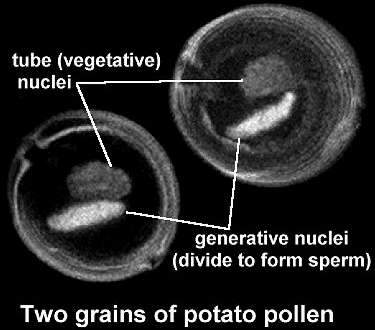Spores

Spores of plants often are incorrectly equated with gametes in treatments of meiosis. Spores upon germination and subsequent development produce gametophytes, the haploid plants that by mitosis produce the gametes, egg and sperm.
In the most common plants, the angiosperms or flowering plants, so-called "male spores" develop into pollen, which is either a two- or three-celled gametophyte when it is shed from the flower. If it is a two-celled gametophyte when it is shed, one of the cells, the generative cell, will divide once to form two sperm when the pollen lands on a receptive flower. In three-celled pollen at shedding, the generative nucleus divided to form the two sperm prior to the pollen being released from the flower.
The egg of angiosperms is produced within an embryo sac (the so-called "female gametophyte"), a structure within the ovule which is contained in the ovary (part of the pistil) of the flower. After pollination (transfer of pollen to the stigma of the pistil) and subsequent fertilization of the egg in the ovule by the sperm from the pollen, the ovule matures to form a seed, which is contained within the fruit (the mature ovary).
